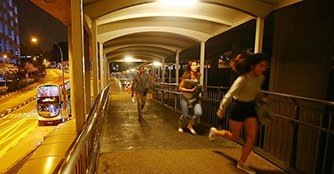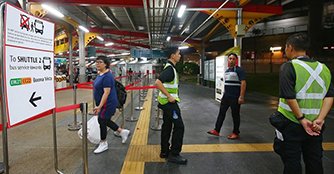New signalling system tested on entire North-South, East-West network
05 Mar 2018|1,306 views
For about five hours early yesterday, trains on both the North-South and East-West lines (NSEWL) ran fully on an upgraded signalling system in a large-scale trial involving more than 100 train drivers. It was the first time the entire NSEWL network was controlled by the new communications-based train control signalling system.

This was more than double the usual duration available for tests. On regular days, tests are carried out only from 2:00am to 4:00am.
Stations along the NSL and EWL have had their operational hours shortened on weekends since December to give engineering staff more time to carry out renewal and maintenance work, including trials for the new signalling system on stretches of the EWL.
The new system is already operating on the NSL. When The Straits Times visited Jurong East MRT station late on Saturday night, train captains were being briefed on the testing requirements for the trial.
They included current train captains and former ones who have assumed non-driving roles in crew management, operations, and training and supervision, as well as Circle Line staff who are trained to drive when support is needed. Some staff sacrificed their days off and family time to be involved in the trial.

He believes such trials allow him to better understand the new system when it is used to run the entire network. "Every day is a learning process for us, so we try to be better at what we do," said the 31-year old, who also discusses his experiences with his colleagues.
Mr. Ramli Rahmat, who has been with SMRT for over 30 years, supports the trials with the planning of manpower resources. His role ensures they are properly deployed, so such tests run smoothly without any hiccups.
It is challenging, said the 55-year old. "We want to make sure that each night, we don't put it to waste. We inform our train captains to take note of whatever is irregular, so that they can report them."
More than 30 signalling engineers and technicians were also deployed around the network to respond to faults during the trial. Mr. Chung Swee Hiang, Chief Engineer for Signals and Communications Maintenance at SMRT, said this allowed faults to be rectified as quickly as possible.
The trial also offered an opportunity for his team to familiarise themselves with the new system, he added. "We want to maximise the early closure and late opening hours given to us, and not waste it."
For about five hours early yesterday, trains on both the North-South and East-West lines (NSEWL) ran fully on an upgraded signalling system in a large-scale trial involving more than 100 train drivers. It was the first time the entire NSEWL network was controlled by the new communications-based train control signalling system.

Commuters rushing to catch one of the last outbound trains at Jurong East MRT station on Saturday night
This was more than double the usual duration available for tests. On regular days, tests are carried out only from 2:00am to 4:00am.
Stations along the NSL and EWL have had their operational hours shortened on weekends since December to give engineering staff more time to carry out renewal and maintenance work, including trials for the new signalling system on stretches of the EWL.
The new system is already operating on the NSL. When The Straits Times visited Jurong East MRT station late on Saturday night, train captains were being briefed on the testing requirements for the trial.
They included current train captains and former ones who have assumed non-driving roles in crew management, operations, and training and supervision, as well as Circle Line staff who are trained to drive when support is needed. Some staff sacrificed their days off and family time to be involved in the trial.

A commuter making her way to the shuttle bus pickup point at Jurong East station after the last outbound train departed from the station on Saturday
He believes such trials allow him to better understand the new system when it is used to run the entire network. "Every day is a learning process for us, so we try to be better at what we do," said the 31-year old, who also discusses his experiences with his colleagues.
Mr. Ramli Rahmat, who has been with SMRT for over 30 years, supports the trials with the planning of manpower resources. His role ensures they are properly deployed, so such tests run smoothly without any hiccups.
It is challenging, said the 55-year old. "We want to make sure that each night, we don't put it to waste. We inform our train captains to take note of whatever is irregular, so that they can report them."
More than 30 signalling engineers and technicians were also deployed around the network to respond to faults during the trial. Mr. Chung Swee Hiang, Chief Engineer for Signals and Communications Maintenance at SMRT, said this allowed faults to be rectified as quickly as possible.
The trial also offered an opportunity for his team to familiarise themselves with the new system, he added. "We want to maximise the early closure and late opening hours given to us, and not waste it."
Latest COE Prices
November 2025 | 1st BIDDING
NEXT TENDER: 19 Nov 2025
CAT A$110,002
CAT B$115,001
CAT C$76,000
CAT E$121,010
View Full Results Thank You For Your Subscription.



















